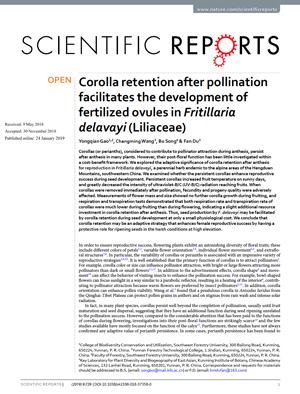NEWS 2019
Corolla retention after pollination facilitates the development of fertilized ovules in Fritillaria delavayi (Liliaceae)
Yongqian GAO1,2, Changming WANG3, Bo SONG4, Fan DU3
Scientific Reports 9: 729 (2019)
https://doi.org/10.1038/s41598-018-37358-0
1College of Biodiversity Conservation and Utilization, Southwest Forestry University, 300 Bailong Road, Kunming, 650224, Yunnan, P. R. China 2Yunnan Forestry Technological College, 1 Jindian, Kunming, 650224, Yunnan, P. R. China 3Faculty of Forestry, Southwest Forestry University, 300 Bailong Road, Kunming, 650224, Yunnan, P. R. China 4Key Laboratory for Plant Diversity and Biogeography of East Asian, Kunming Institute of Botany, Chinese Academy of Sciences, 132 Lanhei Road, Kunming, 650201, Yunnan, P. R. China
Abstract
Corollas (or perianths), considered to contribute to pollinator attraction during anthesis, persist after anthesis in many plants. However, their post-floral function has been little investigated within a cost-benefit framework. We explored the adaptive significance of corolla retention after anthesis for reproduction in Fritillaria delavayi, a perennial herb endemic to the alpine areas of the Hengduan Mountains, southwestern China. We examined whether the persistent corollas enhance reproductive success during seed development. Persistent corollas increased fruit temperature on sunny days, and greatly decreased the intensity of ultraviolet-B/C (UV-B/C) radiation reaching fruits. When corollas were removed immediately after pollination, fecundity and progeny quality were adversely affected. Measurements of flower mass and size showed no further corolla growth during fruiting, and respiration and transpiration tests demonstrated that both respiration rate and transpiration rate of corollas were much lower during fruiting than during flowering, indicating a slight additional resource investment in corolla retention after anthesis. Thus, seed production by F. delavayi may be facilitated by corolla retention during seed development at only a small physiological cost. We conclude that corolla retention may be an adaptive strategy that enhances female reproductive success by having a protective role for ripening seeds in the harsh conditions at high elevation.




